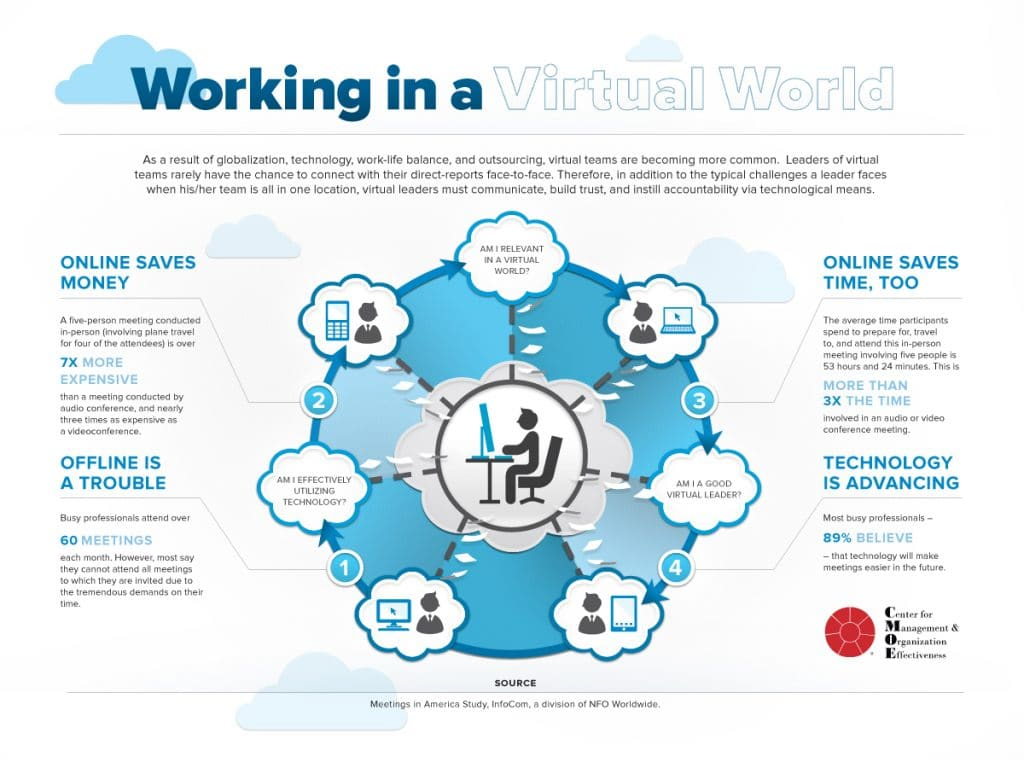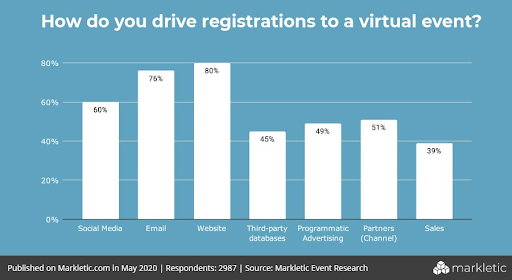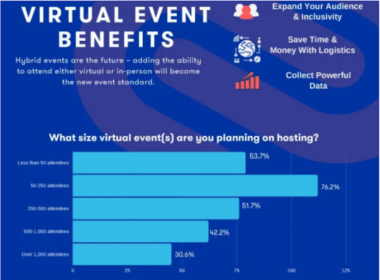Virtual events are the new “in” thing. They offer an opportunity to let people enjoy the comforts of their own home while still being able to enjoy what the world has to offer. An online event could be anything from a music gig to a talk on Robotic Process Automation (RPA).
One of the best parts about virtual events is that anybody can have access to them as long as they have a device and Internet connection. What’s more, virtual events give opportunities to people no matter their age or ability. Your audience could be made up of people from all over the world.
There are of course aspects of real-life events that cannot be achieved in virtual versions. However, there are many ways to improve these “disadvantages,” too, and you can learn how to improve communication in virtual classrooms, concerts, speeches, conferences; the list goes on. Improvement pointers for online events have even been growing for sales events—for example, tips on how to have a successful Black Friday for retailers moving online.
As an event organizer, setting up a virtual event is a little different from a live event, too. But it still has all the great rewards and outcome that comes with live event organizing.
So, without further ado, we present to you the following logistics checklist that will help make your virtual event a roaring success!
Step One: What Are the Goals?
This point will make a huge difference to how the whole thing is run. So, the first thing you need to do is to use that team calendar to get the team together and talk about the event. It may all seem a little obvious, but communication is key in setting up a great event. Otherwise, one team member may have one idea, and another, the total opposite. Setting goals and objectives will make sure you are all on the same page.
You will need to discuss what the point of the event is. How many people do you want to attend? Who will be performing or talking, and how they will be doing it? How long will the event run? Is there a fee? It’s important too to consider whether you will be doing a live or prerecorded event.
Perhaps one of the most important points when it comes to virtual events is figuring out how the event will happen and how the audience will access it. Just like when you’re considering how to organize remote employees, you will need to think about whether people are using phones or computers to talk, or if they are working from an office, an auditorium, or a classroom. Then, make changes to suit the speaker and viewer based on these changes.
Step Two: Think About The Audience


Without an audience, a virtual event is just people talking or performing to themselves in an empty room. Meaning the audience is one of the biggest considerations when setting up an event. Of course, the type of audience you are looking to target will depend on the type of event you are putting on. This will in turn make a difference to how the event is set up.
For example, a classroom and a learning-based event will be aimed at those eager to learn about the subject. Doing a group call with a small number of students will be most beneficial. That way, they will have the opportunity to ask questions in an intimate environment.
However, if you are putting on a virtual play from the houses of Hollywood actors, you will want to aim it toward theater and celebrity lovers. You will also need to ensure that it’s a watch-only event to prevent any distractions from the audience.
In doing a virtual event, you have the potential to access a much wider demographic. So, make the most of being able to reach people across the world. You then need to consider how you will reach them. Will you use paid media? Witty posts on social media? Personalized emails?
Keeping in mind people’s age, geographic location, occupation, etc., will help you to understand your audience as well as the spaces where they are most likely to see the content you share. And not just that, it will help you to figure out how they will be accessing the event too—something that will affect the set-up of the occasion. It will also help you build a better relationship with your virtual event sponsor because it will show that you truly understand your viewers and will be able to pull in the best audience you can.
Also remember that if you are doing live events, you will need to consider the time zone that your audience may be in.
Step Three: Get Technical
Doing a virtual event relies strongly on tech, so it’s important to get it right. Setting up an event doesn’t always just mean switching on the webcam and off the event goes. We have all been victims of the dreaded screen freeze and sound vanishing during online meetings. When putting on an event, this is the last thing you want to happen! Therefore, you need to put the effort into tech to make a good show.
Imagine going to a TED Talk where the sound cuts out or the lights go down halfway through. You would be disappointed, to say the least. You want to make an online event as good as the real thing, and a big part of this is making sure the software and tech are as good as they can be within your budget—especially if you want to make a good name for yourself and monetize virtual events.
This means paying for a great Internet connection and also paying to stream on a good-quality platform. It could also mean setting up a few cameras from different angles. Or, it could mean making sure there is someone in the background to change viewpoints and edit when needed. Adding different angles changes the viewer experience and keeps people interested. If you are doing things live, you may want a delay of a few seconds to deal with any minor issues (such as accidental cursing).
If you are doing a more personalized or educational event, you could even use tech skills to add in an interactive video quiz. That will really get people involved.
You don’t have to put lots of money into the event. But putting that extra bit of money in where possible will make a noticeable difference. It will also increase your chances of making a profit in return. So, see it as an investment.
Step Four: Be Prepared
As with any event, there are always a few “smaller” things to take care of. But these “small” points are very important factors to implement.
Audience size
First, it’s important to market the event properly to ensure you have a good-sized audience. Coming up with a key strategy is a huge part of project management as it’s your door to getting people interested and excited about the event. Make sure that all your strategies across channels match and that you are sending reminders as it gets closer to the time. If the event is prerecorded, you could even show clips of what people can expect and create specific hashtags to get people involved.
Test run
Second, you may decide to do a test run. A dress rehearsal of the occasion is important as it makes sure that each person involved knows what their role is on the big day. It also makes sure that the tech is working as it should be and that all the timings are right. All of this will give the event a professional edge and will make sure you are a trusted firm.
It won’t matter if you are setting up an awards ceremony or a talk on online storage, doing a test run keeps things running smoothly.
Budget
Third, make sure you are within budget. Once you have an idea of how much is being spent, you can figure out any last-minute financial decisions. Now is the time to assess whether that smoke machine is a good idea or if you really need to pay for that extra advertising.
It’s much better to keep an eye on finance running up to the event and make changes, rather than realize you went over the budget once the event is over.
Step Five: Post-Event Tactics
To know if the occasion was as good (or bad) as it seemed, it’s important to get some post-event feedback. This will help improve any virtual events you put on in the future. If you’ve been wondering how to keep people motivated and interested in your event, then giving good feedback may be your answer as it lets them know all the hard work was worth it.
It’s best to do any follow-up as soon as the event is over. Consider if you met the goals and if the tech worked as it should’ve. Contact everyone who attended the event and ask if they enjoyed it and what they would change.
Talk to your team and see what they think worked. You can even discuss why any issues occurred and what you can do to prevent them from happening again. Add these points in for any future events you may be planning.
Remember, too, that it doesn’t matter if you did a webinar on “Alternatives to WebEx” or a four-hour DJ set—send out a thank-you note. You can say thank you to the sponsor, attendees, donors, media, partners, and even the speakers/performers.


Virtual event planning can be just as exciting as real-life event planning. All it needs is a great team, good tech, an interesting topic, and of course, some top-notch organizing. Following these steps will make sure you don’t miss any essential points and that your event is the best it can be.
See also:
- Thinking about Accessibility for Your Virtual Programs
- Experimenting with Digital Escape Rooms
- Organizing a Virtual Wikipedia Edit-a-Thon Event: An Interview with Stacy R. Williams
- 5 Easy Remote Programming Ideas for Public Libraries
- Teaching Remotely? Exploring Creative Ways and Resources to Support Online Learning




